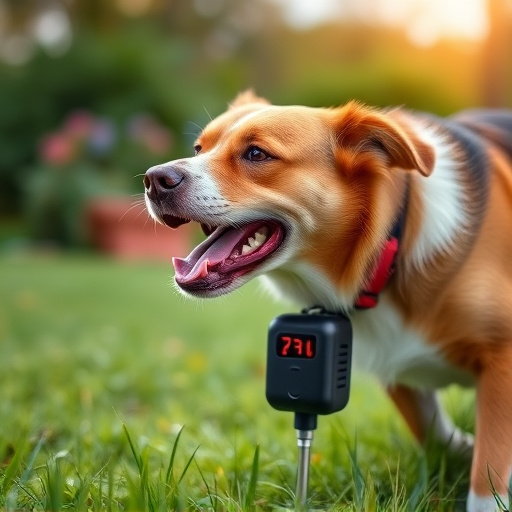Sonic technology repellents offer a humane, effective solution for keeping dogs away from gardens, farms, and pet enclosures with their high-frequency sound waves, ensuring outdoor peace without causing harm. These devices provide extensive coverage, catering to various property sizes, and should be strategically placed to avoid non-target species while adhering to manufacturer guidelines for optimal results in controlling canine intrusions.
“Discover the revolutionary power of sonic technology in pet control with our comprehensive guide. Learn how this innovative approach repels dogs and cats humanely, offering a peaceful solution for outdoor spaces. From understanding the science behind it to evaluating optimal outdoor coverage and range, we demystify its effectiveness. We also delve into safety considerations, ensuring responsible use. Explore the benefits of dog repellent devices and find the best practices for a harmonious coexistence with our furry friends.”
- Understanding Sonic Technology for Pet Control: How It Works
- Benefits of Dog Repellent Devices for Outdoor Areas
- Evaluating Coverage and Range: Ensuring Effective Use
- Safety Considerations and Best Practices for Sonic Pet Deterrents
Understanding Sonic Technology for Pet Control: How It Works
Sonic technology for pet control is an innovative approach to keeping unwanted animals away from your outdoor spaces, particularly effective as a dog repellent device. It operates on the principle of emitting high-frequency sound waves that are inaudible to humans but irritating to animals, primarily dogs and cats. These sound waves disrupt their sensory perception, creating an unpleasant experience that encourages them to stay away from the treated area.
The technology is designed to offer extensive outdoor coverage, making it ideal for use in gardens, farms, or even pet enclosures. It works without causing any harm to the animals, as the sounds are outside the range of human hearing and do not physically damage their bodies. This humane method of control has gained popularity due to its effectiveness and non-lethal nature, providing a peaceful solution to keep pets at bay.
Benefits of Dog Repellent Devices for Outdoor Areas
Dog repellent devices equipped with sonic technology are becoming increasingly popular for outdoor areas, offering a humane and effective solution to manage canine intrusions. These innovative tools emit high-frequency sound waves that are unpleasant to dogs, encouraging them to stay away from specific zones without causing any harm or discomfort to the animals. One of the key benefits is their ability to provide outdoor coverage, making them ideal for use in gardens, patios, and even larger properties where traditional repellents might not be as effective.
By using these devices, pet owners can enjoy their outdoor spaces without worrying about unwanted dog visits. The sonic technology ensures that only dogs can hear the frequency, allowing for a peaceful environment for humans while gently deterring canine intruders. This approach is particularly beneficial for areas where traditional repellents like sprays or electric fences may not be practical or aesthetically pleasing.
Evaluating Coverage and Range: Ensuring Effective Use
When considering a dog repellent device, evaluating its outdoor coverage and range is paramount to ensure its effective use. These devices are designed to create an invisible barrier using high-frequency sound waves, which can be tailored to specific areas like gardens, patios, or fences. However, not all models offer the same level of coverage; some are more suitable for smaller spaces while others cater to larger areas. Understanding the device’s range allows pet owners to make informed choices based on their property size and shape.
For instance, a dog repellent device with a broader range can cover a larger outdoor space, making it ideal for extensive yards or multiple levels of a house. In contrast, compact devices are more suitable for smaller gardens or patios. Effective coverage also depends on the terrain; uneven ground or obstructions like trees or hedges might affect the device’s performance. Therefore, considering these factors ensures that the dog repellent technology is not only effective but also tailored to your specific needs.
Safety Considerations and Best Practices for Sonic Pet Deterrents
When it comes to using sonic technology for pet control, safety is paramount. These devices emit high-frequency sound waves designed to deter animals like dogs and cats without causing harm. However, not all pets or individuals are sensitive to these sounds equally. It’s crucial to place the devices in areas where they won’t affect non-target species, such as beneficial birds or insects. Additionally, ensuring proper outdoor coverage is essential; devices should be strategically positioned to create a protective barrier around sensitive areas without impacting nearby homes or communities.
Best practices include testing the device before deployment to ensure it operates as intended and adjusting settings for optimal effect. Regular maintenance is also key; keeping the device clean and in good working order ensures its effectiveness. Users should follow the manufacturer’s instructions regarding use, as excessive or prolonged exposure to the sound waves might still cause discomfort or stress for some animals. Remember, while sonic pet deterrents offer a humane solution, individual results may vary based on factors like weather conditions, local wildlife behavior, and the device’s specific design.
Sonic technology offers a safe and humane solution for pet control, especially in outdoor areas. By understanding how this technology works and considering factors like coverage and range, you can effectively utilize dog repellent devices. Always prioritize safety and follow best practices when implementing sonic deterrents to ensure a peaceful coexistence between pets and their environments.
